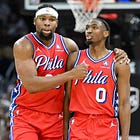Explaining Paul George's Shooting Struggles
The $212 million man is in the midst of his worst shooting season in over a decade.
5.6 points per game. 7.8% from behind the three-point line. 4.2% on two-point field goal attempts, and 9.5% on free throws.
Those numbers are the difference between Paul George’s averages in his last season with the Clippers compared to what he’s done in his first 24 games in a Sixers uniform. The future Hall of Famer is down to 16 points per game on 48-33-81 shooting splits, despite scoring nearly 23 a night last season in Los Angeles while posting the first 50-40-90 season of his entire career. Safe to say, this isn’t quite what the Sixers expected when they signed George to a $212 million deal this summer.
So what’s up? Why has PG seen this much of a decline in his scoring production and shooting efficiency in such a short timeframe?
His at-rim frequency has stayed relatively stable, as has his efficiency on said shots. Likewise, though he’s making fewer off-the-dribble two-point shots than he’s used to, George is attempting them at roughly the same rate as he did in LA. However, there has been a big change in the types of three-pointers he’s taking this season.
Last year with the Clippers, 57% of George’s three-point attempts were catch-and-shoot looks, leaving the other 43% as off-the-dribble looks from three, per Synergy. Contrast that to 2024-25, as 73 of PG’s 154 three-point attempts in Philadelphia are catch-and-shoot looks (47.4%), while the other 77 attempts have come off the dribble (52.6%). No one needs a master’s degree in ball knowing to understand that pull-up shots are generally more difficult than catch-and-shoot jumpers, and thus, George is attempting extremely difficult threes more frequently than he did the year before.
There’s a lot of factors contributing to this. Some of it is squarely on George and the way he’s approached games this season. Other times it’s just a byproduct of the Sixers being so constantly injured that the team lacks offensive rhythm playing together. Another is that shaky ball-handling and playmaking from the team’s guard rotation (particularly since Jared McCain went down with injury in mid-December) has forced George into more ball handling responsibilities himself. He’s having to dribble into looks from straight top-of-the-key ball screen actions far more than he did a year ago in Los Angeles, and the results haven’t been great.
PG is at his best operating as a superstar off-ball weapon, working around a near heliocentric hub out top, such as he did with James Harden last year. From there, he can become one of the deadliest play finishing options in the NBA with his pure shooting skill, alongside his height and high release point that poses issues for rotating defenders.
It makes sense that George looked better and more comfortable on offense when playing next to one of the greatest pick and roll passers in the history of the sport. Not exactly breaking news there, and there’s not much the Sixers can do about that now.
Nick Nurse has tried running more designed sets for George that don’t require him to be a primary initiator. Mainly, the Sixers have run “Top Flare” sets amongst their big three out top, with whoever the other two players on the court are clearing to the weak side corner.
It’s nice to see the Sixers work to get George involved early and often, but even on this play, the results have varied.
Ultimately, it comes down to this — the Sixers brought George to Philly with the idea that he was joining a stacked team he could accentuate. That’s not to say the Sixers shouldn’t have expected any playmaking or self-creation from PG, but those were to be added bonuses on top for a guy who can work as one of the best off-ball players in the league.
Instead, due to the myriad of disasters that have driven this Sixers’ season off a cliff, be it Joel Embiid’s injuries, a season below the typical Tyrese Maxey standard, or Guerschon Yabusele being the lone role player who’s consistently excelled in his spot regardless of the situation, they’ve needed more from George, and here in his age-35 season, he hasn’t quite been able to provide it.
Now as Nurse has said at so many different pressers, some of George’s shooting splits should regress closer toward his career averages at some point. Not all of this is PG taking more difficult attempts than he did in previous years. He’s shooting 10 percentage points worse on catch-and-shoot threes than he did during the 2023-24 season, and in the 12 games he’s played with Embiid, he’s shooting only 29.7% from behind the line. Unless the harrowing curse that’s followed this franchise for a decade truly did cripple the shooting stroke of one of the most prolific marksmen in NBA history, George should start hitting the easier triples at some point.
The bigger concern is that the Sixers don’t have the infrastructure to get him more of those easy threes. He was signed to lift the team to a true championship contending ceiling, and instead, he’s being asked to lift the floor of a team on the outside looking in, a job he is far less suited for at this stage of his career.
The Sixers could try a lot of things to get PG back on track this season, be it putting him in specific off-ball only sets, or by just crossing their fingers and praying for a return to shooting normalcy. But ultimately, they just need to find a way as a whole to play better — and stay healthier — because George’s own shooting success will likely go as the team does.
Daniel Olinger is a writer for the Rights To Ricky Sanchez, and author of “The Danny” column, even though he refuses to be called that in person. He can be followed on X @dan_olinger.
“The Danny” is brought to you by the Official Realtor Of The Process, Adam Ksebe.






